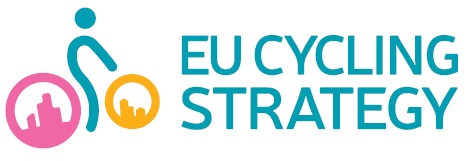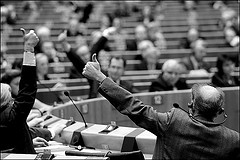EU Cycling Strategy
ECF is lobbying for a genuine cycling strategy at EU level which has been already supported by Member States, the European Parliament, as well as the Committee of the Regions. In September 2016, we launched a campaign for an EU cycling strategy and we appeal to the European Commission to include this strategy among its policy priorities.
 Our policy recommendations include, for instance, an introduction of 30km/h (20mph) zones as the default speed limit in urban areas, or 10% of the EU transport budget dedicated to cycling.
Our policy recommendations include, for instance, an introduction of 30km/h (20mph) zones as the default speed limit in urban areas, or 10% of the EU transport budget dedicated to cycling. Adopting an EU cycling strategy means supporting green economy, healthy lifestyle, environmentally friendly transport, safe infrastructure and sustainable smart cities for the next generations. Hence we believe that the EU should play a more active role in promoting cycling as a fully-fledged transport mode and encourage also its Member States to do so.
More details can be found on the EU Cycling Strategy website.
ECF Manifesto 2019
European Parliament elections
About 250 million Europeans already cycle, and we want that number to become even larger. But what can Europe do about it? Prior to the European Parliament elections in May 2019, ECF’s manifesto listed 10 key actions to be implemented by the EU. You can read here the long version of the manifesto (12 pages).
 We ran a survey to get an idea about what candidates running for the European Parliament think about cycling. Thanks to the tireless efforts of many ECF’s member groups, thousands of candidates across Europe received the survey in their national language.
We ran a survey to get an idea about what candidates running for the European Parliament think about cycling. Thanks to the tireless efforts of many ECF’s member groups, thousands of candidates across Europe received the survey in their national language.
The results were very positive, both in terms of participation and support. More than 360 candidates filled in the survey, thereof 65 candidates who got finally elected for the 2014-2019 parliamentary term. Some of these MEPs have committed to support the Cycling Forum Europe.
For the full results read these pages:
Strong-signs-that-next-european-parliament-will-be-cycling-friendly
Will-you-cycle-to-the-hemicycle-mep-candidate-survey
The 10 recommended actions
1. EU funds for cycle projects
Better provisions for cycling will encourage more people to cycle more often. ECF therefore believes that 10% of all transport budgets should be earmarked for cycling. In the EU, this would translate into €6bn of investments for cycle projects for the period 2014 – 2019. During the previous EU Financial period (2007 – 2013), approximately €600 million (i.e. 0.7 % of EU co-funding) was earmarked for cycling infrastructure from its €82 billion fund for transport infrastructure.
2. Support EuroVelo, the European cycle route network
EuroVelo, the European cycle route network, is a network of 14 long-distance cycle routes that connect the entire continent. EuroVelo is coordinated on the European level by ECF with a network of National EuroVelo Coordination Centres organising the realisation of the routes at a national level. These organisations are working together to complete the network by 2020. Europe’s contribution to that should be the earmarking of TEN-T funds for building EuroVelo infrastructure and by providing financial and technical assistance for the coordination and promotion of the network on the European level.
3. Safer motorised vehicles for pedestrians and cyclists
About half of all fatal accidents in urban areas involve pedestrians and cyclists. As speeding and collisions with motor vehicles are the main killers, action should be urgently taken to improve safety. In order to address speeding, more and more towns and cities have introduced 30 km/h speed limits throughout large parts of their road network. However, this contradicts the Vienna Convention on Road Traffic from 1968 where the default road speed in European built-up urban areas is limited to 50 km/h. ECF thinks it is time that this default speed was lowered to 30 km/h. Lower speed limits also have to be enforced. Intelligent Speed Assistance has proven to be an effective and very cost-efficient tool in doing that. In addition, lorries have to be made safer. Due to the brick shape of the lorry cabin and the high position of the driver, large blind spots occur around the cabin, causing many serious cycling injuries and fatalities .A change in European law should require lorry makers to develop better cabin designs.
4. A level playing-field for cycling with other transport modes
Congestion is one of the main challenges for Europe’s transport system, in particular during peak hours. Many national fiscal regimes give unsustainable transport incentives such as making the provision and use of company cars to employees very attractive. As a result, company cars account for roughly 50 % of all new car sales in the EU. Member States should be encouraged by the EU to introduce fiscal measures to incentivise cycling or remove barriers for cycling for home-work travel. ECF also wants Member States to have the possibility to apply a reduced VAT rate on bicycle sales.
5. Better air quality in Europe
Air pollution caused over 400,000 premature deaths in 2010. 90 % of inhabitants are exposed to one of the most damaging air pollutants at levels deemed harmful to health by the WHO. ECF wants the EU to strengthen its ambient air limits by aligning the Ambient Air Quality directive (AAQD) with the WHO guidelines. In order to improve air quality, cycling must be prioritised over individual motorised transportation. Motor vehicles driving in urban settings – powered two- and three wheelers, cars, vans, trucks – also have to become cleaner.
6. The benefits of cycling in health policy and the health dimension in transport appraisal
Transport and public health are intricately linked. Lack of physical activity is the greatest risk for major lifestyle diseases and the most important cost driver for European health care systems. Active mobility can reduce these costs considerably as prevention is much cheaper than treatment. Similarly, cost-benefit analysis in transport appraisal has shown that investing in cycling delivers higher benefit-cost ratios than investing in individual motorised transport, mainly due to the health benefits of cycling. As a consequence, the EU should recommend that Member States include the benefits of cycling in health policy and to integrate the health dimension in transport appraisal. If transport infrastructure is built with EU money, the health dimension must be integrated.
7. Cycling fully integrated in the multi-modal transport system
Access to mobility rather than owning a private car will become the default solution in the 21st century sharing economy. Cycling must be a full partner in this. If the EU is to fund the development of multi-modal journey planners, information about bicycle networks, access to bike-sharing schemes and bike parking has to be integrated. Likewise, bike-sharing schemes should be a full part of integrated ticketing schemes. On long-distance train journeys, the carriage of complete bicycles should be allowed on all services, amending Regulation EC 1371/2007 on passenger rights’ and obligations accordingly.
8. Statistics and data collection on cycle use
Data is politics. Most importantly, they are being used to justify decisions on what investments in transport infrastructure are to be made. While some Member States collect very good data on cycle use at the national level, others do not. As a consequence, Eurostat does not publish any data on cycle use either. In order to get good data on actual cycling behaviour, ECF recommends the Commission to convene expert groups and expert evaluation to come up with a package of measures for cycle use. Based on the recommendations, the EU and Member States should be required to collect data on cycle use.
9. A European Master Plan for the promotion of cycling
Cycling relates to a whole range of European policy fields. This calls for a horizontal integration to overcome the current piecemeal approach by the different Commission Directorate Generals. 11 EU Member States have a current national strategy on cycling in place, defining objectives, tools and likely outputs, but also giving a strong signal to all other authorities at local and regional policy that cycling matters. The European Commission should follow the national example and develop and publish a European Master Plan on the promotion of cycling at the latest by 2019.
10. An EU transport modal split target for 2030
The EU has set itself very concrete targets on many policy issues, including on transport and urban mobility. For example, the Commission wants to phase out the use of ‘conventionally-fuelled’ cars in cities by 2050; and achieve essentially CO2-free city logistics in major urban centres by 2030. While ECF welcomes the urban mobility targets, we think it is crucial to add to it a transport modal split target as a meaningful supplement. If today’s ‘conventionally-fuelled’ cars in cities will be simply replaced by non-conventionally fuelled cars, e.g. e-cars, nothing will be gained in improving the quality of public space in urban areas, in solving the lack of inner-city parking facilities or in increasing physical activity of EU citizens. At least 6 EU Member States have set specific targets on cycle use.
